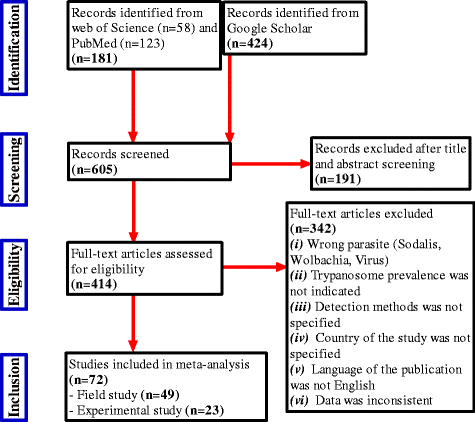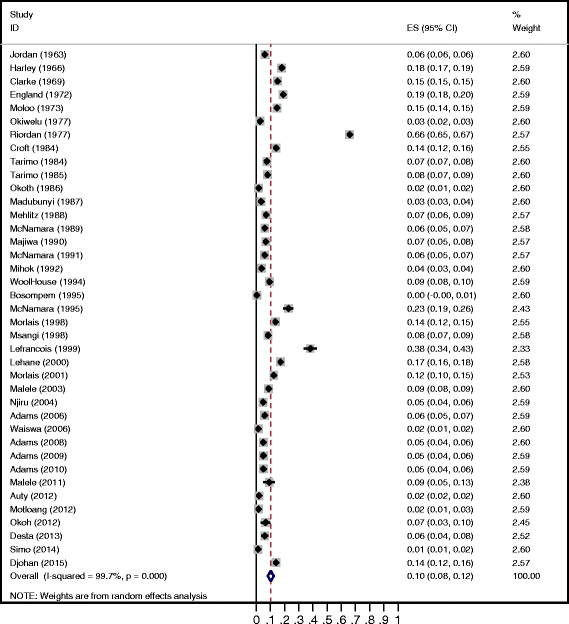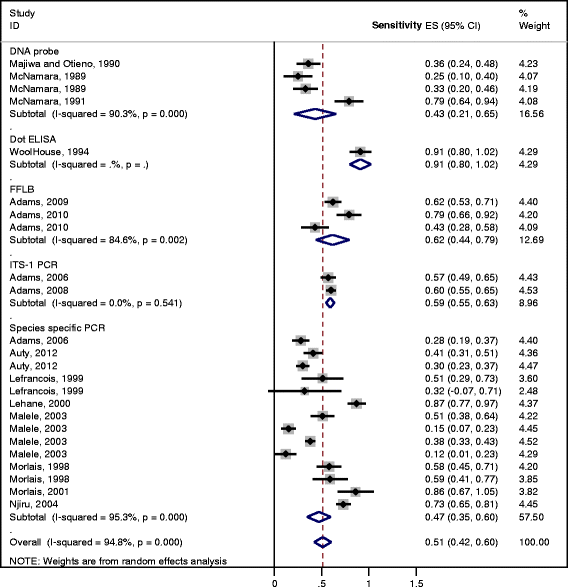A systematic review and meta-analysis of trypanosome prevalence in tsetse flies
- PMID: 28403841
- PMCID: PMC5390347
- DOI: 10.1186/s12917-017-1012-9
A systematic review and meta-analysis of trypanosome prevalence in tsetse flies
Abstract
Background: The optimisation of trypanosomosis control programs warrants a good knowledge of the main vector of animal and human trypanosomes in sub-Saharan Africa, the tsetse fly. An important aspect of the tsetse fly population is its trypanosome infection prevalence, as it determines the intensity of the transmission of the parasite by the vector. We therefore conducted a systematic review of published studies documenting trypanosome infection prevalence from field surveys or from laboratory experiments under controlled conditions. Publications were screened in the Web of Science, PubMed and Google Scholar databases. Using the four-stage (identification, screening, eligibility and inclusion) process in the PRISMA statement the initial screened total of 605 studies were reduced to 72 studies. The microscopic examination of dissected flies (dissection method) remains the most used method to detect trypanosomes and thus constituted the main focus of this analysis. Meta-regression was performed to identify factors responsible for high trypanosome prevalence in the vectors and a random effects meta-analysis was used to report the sensitivity of molecular and serological tests using the dissection method as gold standard.
Results: The overall pooled prevalence was 10.3% (95% confidence interval [CI] = 8.1%, 12.4%) and 31.0% (95% CI = 20.0%, 42.0%) for the field survey and laboratory experiment data respectively. The country and the year of publication were found to be significantly factors associated with the prevalence of trypanosome infection in tsetse flies. The alternative diagnostic tools applied to dissection positive samples were characterised by low sensitivity, and no information on the specificity was available at all.
Conclusion: Both temporal and spatial variation in trypanosome infection prevalence of field collected tsetse flies exists, but further investigation on real risk factors is needed how this variation can be explained. Improving the sensitivity and determining the specificity of these alternative diagnostic tools should be a priority and will allow to estimate the prevalence of trypanosome infection in tsetse flies in high-throughput.
Keywords: Diagnostic methods; Glossina; Meta-regression; Systematic review; Trypanosome infection prevalence.
Figures




References
-
- Murray M, Gray AR. The current situation on animal trypanosomiasis in Africa. Prev Vet Med. 1984;2(1):23–30. doi: 10.1016/0167-5877(84)90045-X. - DOI
-
- Kristjanson PM, Swallow BM, Rowlands GJ, Kruska RL, De Leeuw PN. Measuring the costs of African animal trypanosomosis, the potential benefits of control and returns to research. Agric Syst. 1999;59(1):79–98. doi: 10.1016/S0308-521X(98)00086-9. - DOI
Publication types
MeSH terms
LinkOut - more resources
Full Text Sources
Other Literature Sources

